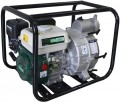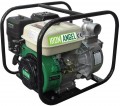Suitable for
— Pure water. Pure water pumps conventionally include all models for which the maximum particle size (see below) does not exceed 5 mm; in addition, the permissible content of mechanical impurities (also see below) for them is also small. Accordingly, many of these models are capable of pumping water with impurities normally, but they are not suitable for heavily contaminated liquids.
— Dirty water. This category includes pumps capable of working with large mechanical impurities — more than 5 mm. Note that some manufacturers position such models as mixed-use units, “for dirty and clean water”. However, they have a reinforced design, the presence of a grinder capable of grinding the particles mentioned, a reinforced body, an increased diameter of pipes, increased power, etc. .P. The main difference between such pumps and waste water pumps (see above) is the impossibility of working with high-viscosity liquids.
— Waste water. Waste water pumps are in many ways similar to the models for dirty water described above because they also have to deal with large particles. The main difference is the allowable size of these particles — it is 50 mm or more; in addition, the entire design of such pumps is created based on the high viscosity of the pumped liquid.
— Chemical liquids. Pumps designed to work with chemical liquids are distinguished primarily by the use of highly resistant materials in the design — usually polymers. Due to this, they can endur...e working with aggressive substances without consequences — acids, alkalis, oil products, solvents, liquefied gases, etc. In addition, other special solutions are often used in “chemical” pumps, which allow the safe pumping of flammable and explosive materials, very cold, hot, viscous liquids, etc. The main scope of such units is the industry — both chemical and oil, food, etc. Note that different models can be designed for different types of substances.
Maximum performance
The maximum volume of water that the device can pump in a certain amount of time. It is one of the key specs of any pump because characterizes the volume of water with which the device can work. At the same time, it does not always make sense to pursue maximum performance — after all, it significantly affects the dimensions and weight of the unit.
Some formulas allow you to derive optimal performance values for different situations. So, if the pump is designed to supply water to water intake points, its minimum required performance should not be lower than the highest total flow rate; if desired, a margin of 20-30% can be added to this value. And for sewer models (see "Suitable for"), everything will depend on the volume of wastewater. More detailed recommendations for choosing a pump depending on performance can be found in special sources.
Maximum head
The maximum head generated by the pump. This parameter is most often indicated in meters, by the height of the water column that the unit can create — in other words, by the height to which it can supply water. You can estimate the pressure created by the pump using a simple formula: every 10 m of head corresponds to a pressure of 1 bar.
It is worth choosing a pump according to this parameter, taking into account the height to which it should supply water, as well as adjusting for losses and the need for pressure in the water supply. To do this, it is necessary to determine the difference in height between the water level and the highest point of water intake, add another 10 to 30 m to this figure (depending on the pressure that needs to be obtained in the water supply), and multiply the result by 1.1 — this will be the minimum pressure required.
Suction height
The largest difference between the height of the pump and the height of the water level at which the pump can provide normal suction. Without special devices, the maximum value of this parameter is 7-8 m — this is due to the physics of the process. However, when using an ejector (see below), the suction height can be increased several times.
Outlet size
The thread size for connecting a hose or pipe to the pump outlet. If there is a branch pipe with an external thread in the design, the size is indicated for it; if not, for the internal thread of the inlet.
Anyway, the dimensions of the pump outlet and the mounts on the hose/pipeline connected to it must match — otherwise, you will have to look for adapters. This size is specified in inches and fractions of an inch.
This parameter is relevant primarily for surface models.
Inlet hole size
The size of the thread designed to connect the pump to the suction line. This parameter is completely similar to the size of the outlet (see above) — in particular, it can be specified both for the nozzle and for the inlet of the pump.
Fuel tank volume
The volume of the fuel tank in the water pump with an internal combustion engine (see "Power source"). Knowing this parameter and fuel consumption, it is possible to determine the maximum operating time of the unit on a single refill. Of course, the larger the tank, the longer the pump can work without refuelling, all other things being equal; on the other hand, a large capacity significantly affects the dimensions and weight of the device.

